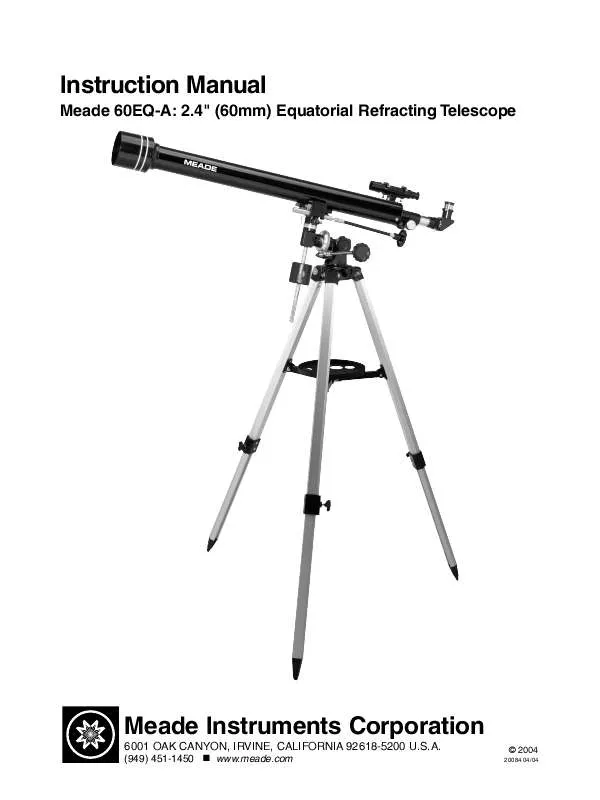User manual MEADE 60 EQ-A Instruction Manual
Lastmanuals offers a socially driven service of sharing, storing and searching manuals related to use of hardware and software : user guide, owner's manual, quick start guide, technical datasheets... DON'T FORGET : ALWAYS READ THE USER GUIDE BEFORE BUYING !!!
If this document matches the user guide, instructions manual or user manual, feature sets, schematics you are looking for, download it now. Lastmanuals provides you a fast and easy access to the user manual MEADE 60 EQ-A. We hope that this MEADE 60 EQ-A user guide will be useful to you.
Lastmanuals help download the user guide MEADE 60 EQ-A.
Manual abstract: user guide MEADE 60 EQ-AInstruction Manual
Detailed instructions for use are in the User's Guide.
[. . . ] Instruction Manual
Meade 60EQ-A: 2. 4" (60mm) Equatorial Refracting Telescope
Meade Instruments Corporation
6001 OAK CANYON, IRVINE, CALIFORNIA 92618-5200 U. S. A.
(949) 451-1450 s www. meade. com
© 2004
20084 04/04
2
WARNING:
NEVER USE A MEADE 60MM REFRACTOR TELESCOPE TO LOOK AT THE SUN!LOOKING AT OR NEAR THE SUN WILL CAUSE INSTANT AND IRREVERSIBLE DAMAGE TO YOUR EYE. EYE DAMAGE IS OFTEN PAINLESS, SO THERE IS NO WARNING TO THE OBSERVER THAT DAMAGE HAS OCCURRED UNTIL IT IS TOO LATE. DO NOT POINT THE TELESCOPE OR ITS VIEWFINDER AT OR NEAR THE SUN. [. . . ] The "zero" line was arbitrarily chosen to pass through the constellation Pegasus, a Rotation of the sort of cosmic Greenwich meridian. coordinates range Earth from 0hr 0min 0sec to 23hr 59min 59sec. There are 24 primary Right lines of R. A. , located at 15-degree intervals along the celestial Ascension equator. Objects located further and further East of the zero R. A. grid line (0hr 0min 0sec) carry higher R. A. Celestial Pole Declination (Dec. ): This celestial version of latitude is measured in degrees, arc-minutes, and arc-seconds (e. g. , 15° 27' 33"). locations North of the celestial equator are Fig. indicated with a plus (+) sign (e. g. , the Dec. of the North celestial pole is +90°). locations South of the celestial equator are indicated with a minus () sign (e. g. , the Dec. of the South celestial pole is 90°). Any point on the celestial equator (such as the the constellations of Orion, Virgo, and Aquarius) is said to have a Declination of zero, shown as 0° 0' 0. " See Fig. 8.
ation clin De
16 15 14 13 12 11 10 9 8 17 18 19 7 6 5 20 21 22 23 0 1 2 4 3 0° Dec.
North Celestial Pole (Vicinity of Polaris)
+90° Déc.
As all celestial objects therefore may be located with their celestial coordinates of Right Ascension and Declination, the task of finding objects (in particular, faint objects) in the telescope is vastly simplified. 2) of your telescope may be dialed, in effect, to read the object coordinates and the object found without resorting to visual location techniques. However, these setting circles only perform correctly if the telescope is properly aligned with the North Celestial Pole.
LINING UP WITH THE CELESTIAL POLE
Objects in the sky appear to revolve around the celestial pole. (Actually, celestial objects are essentially "fixed, " and their apparent motion is caused by the Earth's rotation). During any 24 hour period, stars make one complete revolution about the pole, circling with the pole at the center. By lining up the telescope's polar axis (40, Fig. 2) with the North Celestial Pole (or for observers located in Earth's Southern Hemisphere with the South Celestial Pole), astronomical objects may be followed, or "tracked, " by moving the telescope about one axis, the polar axis.
Little Dipper
Polaris
Big Dipper
Cassiopeia
Figure 9: Finding Polaris
If the telescope is reasonably well aligned with the pole, therefore, very little use of the telescope's Declination flexible cable control is necessary and virtually all of the required telescope tracking will be in Right Ascension. (If the telescope were perfectly aligned with the pole, no Declination tracking of stellar objects would be required whatsoever). For the purposes of casual visual telescopic observations, lining up the telescope's polar axis to within a degree or two of the pole is more than sufficient: with this level of pointing accuracy, the telescope can track accurately by slowly turning the telescope's R. A. flexible cable control and keep objects in the telescopic field of view for perhaps 20 to 30 minutes.
POLAR ALIGNMENT OF THE EQUATORIAL MOUNT
To line up the Meade 60EQ-A with the pole, follow this procedure: 1. [. . . ] Insert the 2X Barlow lens into the the diagonal prism, followed by the eyepiece, and secure by tightening the respective thumbscrews. For example, the 25mm (36X) eyepiece, when used in conjunction with the 3X Barlow Lens, provides 108X. The 9mm eyepiece provides 100X; when used the 2X Barlow, it provides 200X. The letters "MA" refers to the "Modified Achromatic" optical design, which yields corrected images with refractor telescopes. [. . . ]
DISCLAIMER TO DOWNLOAD THE USER GUIDE MEADE 60 EQ-A Lastmanuals offers a socially driven service of sharing, storing and searching manuals related to use of hardware and software : user guide, owner's manual, quick start guide, technical datasheets...manual MEADE 60 EQ-A


